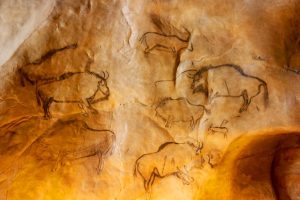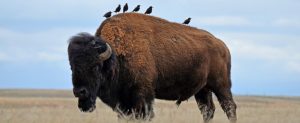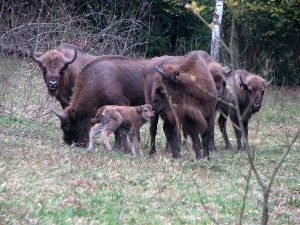Podcast: Play in new window | Download (Duration: 11:29 — 12.7MB)
Thanks to Jason for suggesting this week’s topic, the bison!
Further reading:
New research documents domestic cattle genetics in modern bison herds
Higgs Bison: Mysterious Hybrid of Bison and Cattle Hidden in Ice Age Cave Art
A cave painting of steppe bison and other animals:

An American bison [photo by Kim Acker, taken from this site]:

Some European bison [photo by Pryndak Vasyl, taken from this site]:

The bison sound in this episode came from this site.
Show transcript:
Welcome to Strange Animals Podcast. I’m your host, Kate Shaw.
This week we’re going to learn about the bison, a suggestion from Jason. There are two species of bison alive today, the American bison and the European bison. Both are sometimes called buffalo while the European bison is sometimes called the wisent. I’m mostly going to call it the wisent too in this episode so I only have to say the word bison 5,000 times instead of 10,000.
Bison are herd animals that can congregate in huge numbers, but these big herds are made up of numerous smaller groups. The smaller groups are made up of a lead female, called a cow, who is usually older, other cows, and all their offspring, called calves. Males, called bulls, live in small bachelor groups. The American bison mostly eats grass while the European bison eats a wider selection of plants in addition to grass.
The bison is a big animal with horns, a shaggy dark brown coat, and a humped shoulder. The American bison’s shoulder is especially humped, which allows for the attachment of strong neck muscles. This allows the animal to clear snow from the ground by swinging its head side to side. The European bison’s hump isn’t as pronounced and it carries its head higher. The bison looks slow and clumsy, but it can actually run up to 35 mph, or 55 km/hour, can swim well, and can jump obstacles that are 5 feet tall, or 1.5 meters.
The American bison can stand over six and a half feet high at the shoulder, or 2 meters, while the European bison stands almost 7 feet tall at the shoulder, or 2.1 meters. This is massively huge! Bison are definitely ice age megafauna that once lived alongside mammoths and woolly rhinos, so we’re lucky they’re still around. Both species almost went extinct in recent times and were only saved by a coordinated effort by early conservationists.
The American bison in particular has a sad story. Before European colonizers arrived, bison were widespread throughout North America. Bison live in herds that migrate sometimes long distances to find food, and many of the North American tribes were also migratory to follow the herds, because the bison was an important part of their diet and they also used its hide and other body parts to make items they needed. The colonizers knew that, and they knew that by killing off the bison, the people who depended on bison to live would starve to death. Since bison were also considered sacred, the emotional and societal impact of colonizers killing the animals was also considerable.
In the 19th century, colonizers killed an estimated 50 million bison. A lot of them weren’t even used for anything. People would shoot as many bison as possible from trains and just leave the bodies to rot, and this practice was actually encouraged by the railroads, who advertised these “hunting” trips. The United States government also encouraged the mass killing of bison and even had soldiers go out to kill as many bison as possible. Bison that escaped the coordinated slaughter often caught diseases spread by domestic cattle, and the increased plowing and fencing of prairie land reduced the food available to bison. By 1900, the number of American bison in the world was probably only about 300.
As early as the 1860s people started to sound the alarm about the bison’s impending extinction. Some ranchers kept bison, partly as meat animals and partly to just help stop them from all dying out. The Yellowstone National Park had been established in 1872, and 25 bison survived there, although many others were poached by hunters. Members of various Plains tribes, who had been forced onto reservations by the United States government so the government could give their land to colonizers, collected as many bison as they could to keep them safe.
These days the American bison is out of immediate danger, although its numbers are still very low. Because there were so few bison when conservation efforts started, the genetic diversity is also low. Bison will also hybridize with domestic cattle and the resulting female calves are fertile, so the main goal of modern conservationists is to genetically test herds to determine which bison have a larger percentage of cattle genes, and mainly only breed the ones that have the least. A 2022 study determined that there is no population of American bison alive today that doesn’t have at least a small percentage of cattle genes. Cattle are domesticated animals, and it’s never a good thing when a wild animal ends up with the DNA of a domestic counterpart. Bison need their wildness in order to survive and stay safe.
There are two living subspecies of American bison, the wood bison and the plains bison. I’m happy to report that the scientific name of the plains bison is Bison bison bison. The wood bison mainly lives in Canada, where it’s classified as threatened.
As for the European bison, or wisent, it was once common throughout much of Europe and Asia. As the human population increased after the ice age, the wisent’s numbers decreased until it was mostly restricted to a few areas of Russia, Transylvania, Poland, and Lithuania. Even as early as the 16th century, people were aware it was endangered. Local rulers declared it a protected animal in most of its range.
During World War I, German troops occupying Poland killed hundreds of wisents, and as the troops retreated at the end of the war, they shot as many of the bison as they could find and left them to rot. Only nine individuals remained alive and by 1921 they had died too. By 1927, the very last wisent in the wild was killed by a poacher.
But 12 animals remained, kept in various zoos. In 1923 a preservation society was set up, modeled after the one in the United States that had helped save the American bison from extinction. Poland in particular worked hard to increase the wisent’s numbers and re-introduce it to its forest home, although its efforts were interrupted by World War II. These days the wisent is out of danger of extinction, although like the American bison its numbers are still relatively low.
American and European bison are related and can crossbreed, but they’re not as closely related genetically as was once thought. Genetic studies are ongoing, but it appears that the wisent is most closely related to domestic cattle while the American bison is most closely related to the yak.
We recently talked about the steppe bison in episode 357, which is about mammoth meat. The steppe bison is an ancestor of the American bison and lived throughout Europe and Asia across to North America, during the Pleistocene when Asia and North America were connected by the land bridge Beringia. It only went extinct around 3,000 years ago. It had much larger horns than modern bison, with a horn spread of almost seven feet across, or over 2 meters.
About 17,000 years ago, in a cave in what is now France, an ancient artist picked up a stick of charcoal and made a drawing of a bison alongside many other bison drawings made by many artists over the years. According to a study published in 2016, there are two different types of bison depicted in the cave. One type is the steppe bison, but the other is distinctly different. After a genetics study of bison in Europe, researchers made a surprising discovery. The second type of bison depicted in the cave is actually a hybrid animal. Hybrids come about when two species of closely related animals interbreed. The more closely related the species are, the more likely they are to interbreed where their territories overlap, and the more likely that the offspring will be fertile. This is exactly what happened toward the end of the Pleistocene, when climate change made it harder for the steppe bison to survive. Instead, a hybrid of steppe bison and the aurochs, the wild ancestor of the domestic cow, not only became common throughout much of Europe, eventually the hybrid species was so numerous that it became a distinct species of its own.
This hybrid bison had small horns and a smaller hump than the steppe bison, although it was still a really big animal. Eventually it gave rise to the modern European bison while the steppe bison gave rise to the antique bison, which itself is the direct ancestor of the American bison. So many bison!
This is what a bison sounds like, specifically an American bison recorded in Yellowstone National Park:
[bison sound]
You can find Strange Animals Podcast at strangeanimalspodcast.blubrry.net. That’s blueberry without any E’s. If you have questions, comments, or suggestions for future episodes, email us at strangeanimalspodcast@gmail.com. We also have a Patreon at patreon.com/strangeanimalspodcast if you’d like to support us for as little as one dollar a month and get monthly bonus episodes.
Thanks for listening!